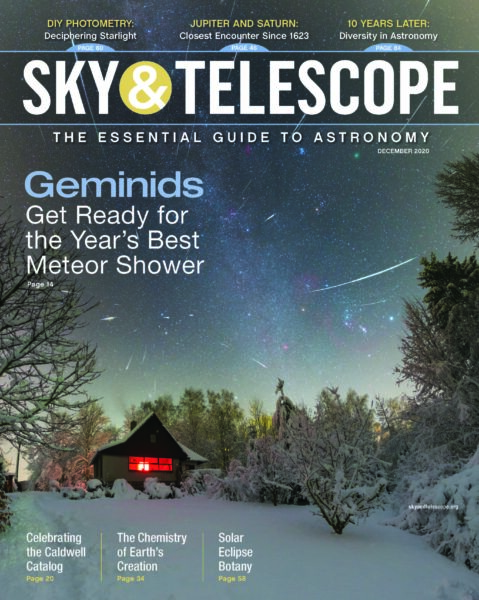
The Geminid Meteor Shower, Cosmic Dust, and the Caldwell Catalog
In the December 2020 issue of Sky & Telescope, we’re preparing for the best meteor shower of the year and talking about dust. The Geminids peak on December 13–14, and we’ve got tips for watching. We also dig into cosmic dust — meteors and otherwise — which colors every aspect of our view of the universe. Dust’s most important ingredient, perhaps, is carbon, and we trace its history from the solar system’s earliest years to find out what why Earth developed with just the right amount of it. While watching the Geminids this month, why not break out the astrophotography gear and do a little science with the stars? We detail exactly how to measure stellar brightness using amateur equipment. Speaking of stars, how do plants get along without one (at least for a little while)? As totality shadows Argentina and Chile this month, we find out what plants in our front yard think about totality.
FEATURE ARTICLES:
“It’s the most wonderful time of the year . . .” to see meteors!
By Joe Rao
This popular list of observing targets published in 1995 is marking its first quarter-century.
By Mathew Wedel
When thinking about cosmic wonders, we often wrongly sweep interstellar dust under the rug.
By Christopher Crockett
There’s another ingredient besides water that’s crucial to the recipe for life.
By Edwin Bergin
What Does Your Lawn Think of a Solar Eclipse?
Humans aren't the only lifeforms that notice totality.
By David Billesbach & Timothy Arkebauer
Here's how you can contribute to the science of astronomy.
By Richard Berry
Beyond the Printed Page:
Enjoy the Hubble Space Telescope’s Caldwell Catalog, which contains images of 56 objects from Moore’s list.
Read these tips from the International Meteor Organization for a comfortable night under the Geminids.
The Total Solar Eclipse over South America
Watch the next total solar eclipse live from Patagonia.
Build your own backyard radio telescope with these instructions.
ALSO IN THIS ISSUE:
A Long Night’s Journey Into Day
The dark of winter offers plenty of time for skygazing and quiet contemplation.
By Fred Schaaf
A South American Total Eclipse
The Moon’s shadow visits Chile and Argentina again.
By Bob King
Warm rocks hint at recent geological activity.
By Charles Wood
Clusters and nebulae abound in compact Cassiopeia.
By Sue French
Table of Contents
See what else December's issue has to offer.
 0
0

Comments
You must be logged in to post a comment.